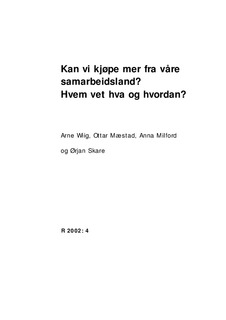| dc.description.abstract | This report explores the potential for increasing imports to Norway from its main development partners. The analysis is based on three main indicators: i) a trade intensity index (commodities which the development partners are exporting, but where Norway is importing relatively less than similar OECD countries); ii) the peak tariff rates (commodities where tariff rates are high); and iii) the utilisation rate of commodities with preferential tariffs (commodities where the development partners are not fully utilising the preferences). In addition, interviews were conducted with Norwegian importers of clothing, toys, food and gifts to identify their problems when importing from developing countries. Finally, the report identifies persons and institutions with expertise on problems faced by developing countries when trying to penetrate the Norwegian market.
We find that Norway is importing relatively less than other OECD countries from most of its development partners, particularly for agricultural products. Based on the trade intensity index, we identify a further import potential of products such as prawns, coffee, sugar, fruits and nuts.
Norway has particularly high tariffs on clothing and agricultural products. Tariffs on clothing favour the least developed countries (LDCs) and members of the European Economic Area (EEA) at the cost of ordinary developing countries, which do not have preferential treatment.
Extending such preferential treatment to all developing countries will spur imports from China in particular.
From 1 July 2002, all imports from LDCs to Norway will have duty free access. In the short run, the import potential of agricultural products from LDCs seems limited, since these countries are net importers of the relevant product categories.
The utilisation rate of Generalised System of Preferences (GSP) in Norway is about 80 percent and China is the primary beneficiary. We argue for targeting the GSP system towards LDCs. We also argue that Norway should liberalise its rules of origin for clothing products in order to increase the utilisation rate. The project is financed by the Norwegian Agency for Development Cooperation (NORAD). | |
